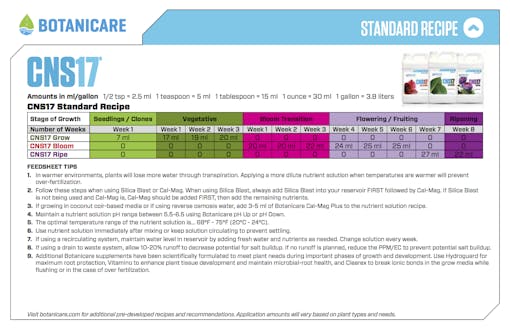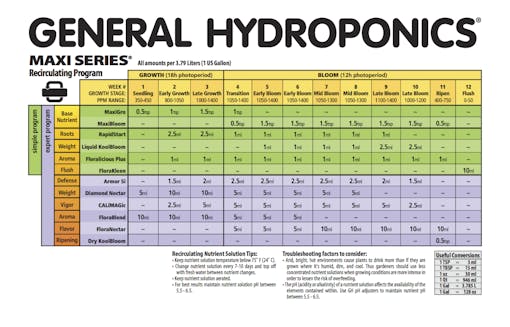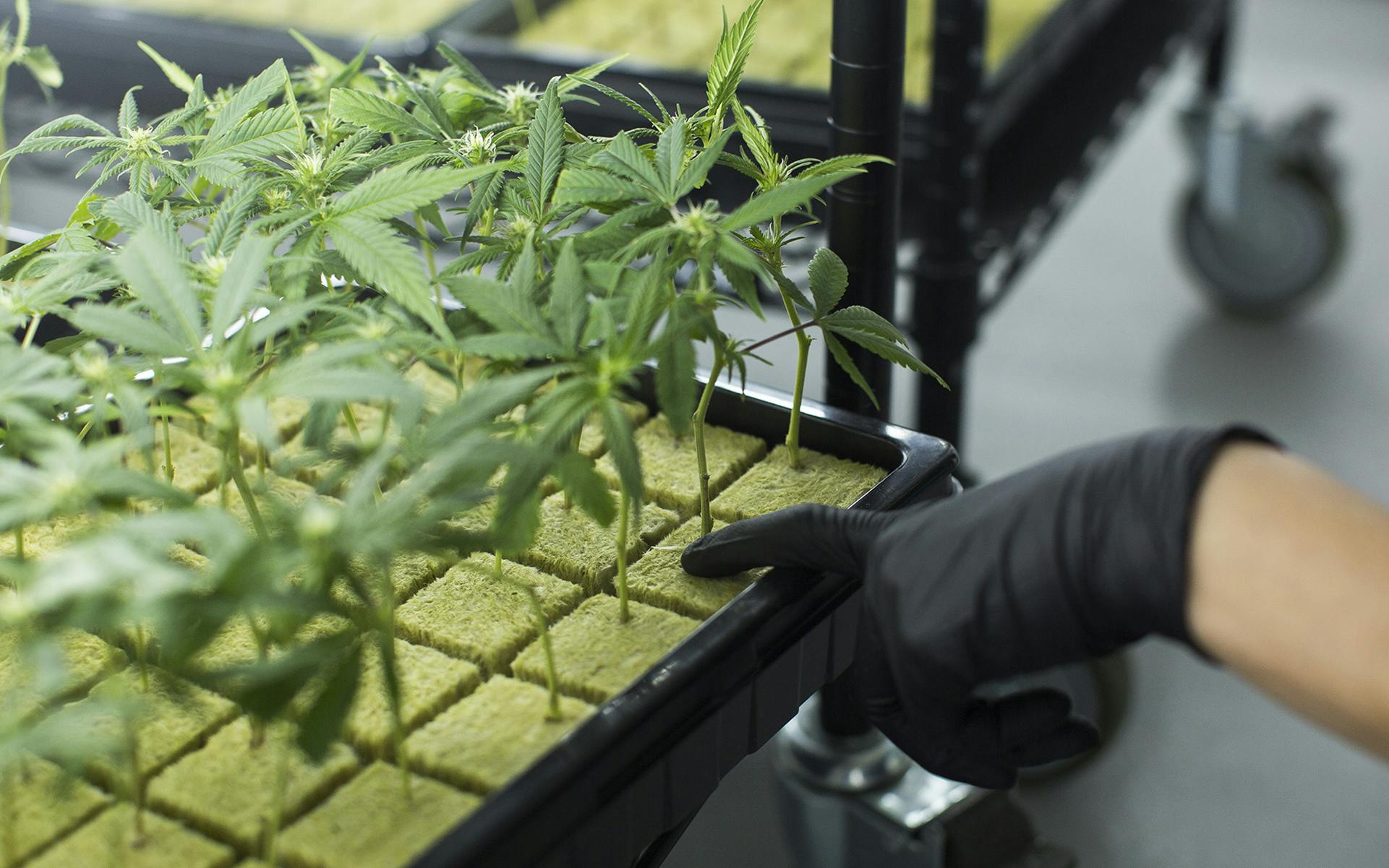This article is sponsored by General Hydroponics, the leading innovator in the field of hydroponics for more than 35 years.
A helpful tool used by diligent cannabis cultivators is a feed chart. Feed charts are specific recommendations and guidelines provided by nutrient companies to help farmers achieve the healthiest and best crop possible. How and when a nutrient is introduced will trigger responses from the plant, and feed charts can help you understand what products you need to use and when they should be applied. This knowledge is particularly important in hydroponic gardens where you have complete control over nutrients.
Cannabis can be fed varying amounts of nutrient concentrations depending on the strain, stage of growth, and environment; introducing too many or too few nutrients to a cannabis plant can cause great harm to your garden. This is where feed charts come in handy. They provide specific instructions indicating when and where nutrient products should be applied.
It’s important to note that different plants have unique nutritional needs during each phase of the growing cycle. Feed charts can provide an excellent foundation for novice growers, but as your skills develop, you may find it necessary to adjust feed charts based on your plant’s specific needs. In time, you’ll be able to create customized charts that take into consideration strain attributes, climate, water quality, and other factors. Remember, horticulture is a form of art, and practice makes perfect.
Reading Feed Charts for Cannabis Gardens
Although the concept of a feed chart might sound simple, you’ll first need to learn how to read one. Generally speaking, a feed chart is broken down into a grid. One axis lists nutrients while the other axis provides timeline information. For example, a hydroponic feed chart may be broken down in a week-by-week format, with different nutrients assigned to different weeks.
Most feed charts provide a ratio of nutrients per gallon of solution. Let’s say week one calls for 2.5mL of a nutrient—you would simply add 2.5mL of that nutrient per gallon into your solution. If you’re making 50 gallons of solution, multiply 2.5 by 50 and you’ll find that you need 125mL total in your 50 gallon tank.
Once you have mixed the nutrients into your solution, use a PPM (parts per million) reader to ensure the nutrient solution isn’t stronger than the chart advises. Additionally, feed charts may instruct you to add specific nutrients prior to other nutrients.
How to Adjust a Feed Chart
Feed charts provide loose instructions on how to effectively feed your cannabis, but they can always be adjusted to better suit the specific needs of your garden. To adjust a feed chart, first familiarize yourself with the suggested chart and know how your plants respond after these recommended feedings. Understanding a plant’s response to any given nutrient will help you predict how it will be affected when you increase or decrease that nutrient.
The key to successfully adjusting a feed chart is to record everything using a daily journal. Write down what the plants are being fed and when, as well as how the plants responded to the nutrients. By doing this, you can start identifying trends. For example, you might notice that you aren’t increasing vegetative nutrients fast enough to keep up with the size of your plants, or that bud growth is lacking in specific weeks. Having observed this through your notes, you’ll know to increase your nutrient solution at a slow pace.
When adjusting a feed chart, be aware of nutrient lockout and how it compares to nutrient deficiency. A lockout will occur when there is a buildup of nutrients in the grow medium, which then prohibits your plants from uptaking nutrients. This is the opposite of a nutrient deficiency, but they end up looking the same since, in both cases, the plant is not receiving its nutrients. However, by keeping track of your feedings, you should easily be able to tell if you have been underfeeding or overfeeding your plants.
Common Questions About Feed Charts
Below are some frequently asked questions about feed charts. Knowing the answers will help you successfully keep and maintain a feed chart of your own.
What’s the Difference Between Simple and Expert Charts?
The difference between simple and expert charts is based on the number of nutrients used. Simple charts will supply your garden with everything it needs to thrive, but expert charts will introduce a longer list of nutrients to improve your garden. The additional nutrients may increase the plant’s yield, enhance aroma, and flavor, and/or lend an extra boost to its growth and immune system.

Click to view a PDF version of this sample standard/basic feed chart, as well as an example of an expert feed chart for comparison
What Are Drain-to-Waste and Recirculating Systems?
Drain-to-waste systems use nutrient solutions only once, whereas a recirculating system will recycle the runoff. Both of these systems have upsides and downsides.
The advantages of a drain-to-waste system include:
- Nutrients are more fresh and consistent
- The pH stays stable
- Undesirable pathogens are less likely to spread between plants
On the other hand, a drain-to-waste system wastes nutrients that are left in the runoff.
Recirculating systems are more economical as they maximize nutrients. However, there are some issues associated with recirculated nutrients:
- The pH and nutrient levels of your solution can change as old nutrients are recirculated into your feeding tank
- Recirculating your solution may allow unwanted pathogens to be spread between plants
Why Do Numbers on the Bottle Differ From the Chart?
Numbers differ between feed charts and bottles because a feed chart plans for the combination of multiple nutrients, while the bottle accounts only for the use of a single nutrient in isolation. Using only the recommendations on each nutrient bottle, you may find yourself with a solution that is too strong for your plants to handle.
What Does PPM Mean?
PPM (parts per million) is a measurement that is used to identify the density of a nutrient solution. Using a PPM reader allows you to accurately measure the nutrients going into your garden, information that is vitally important when addressing nutrient lockout or deficiency.
Why Are pH Levels Important?
If the pH level is too high or too low, your plants cannot uptake the nutrients they need to thrive. Keeping a pH between 5.5 and 6.5 for hydroponic grows–or 6.0 and 6.8 for soil gardens–is absolutely necessary for your plants to reach their full potential.








